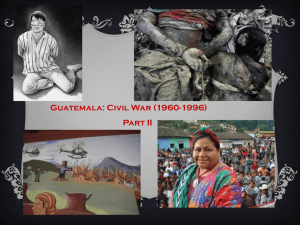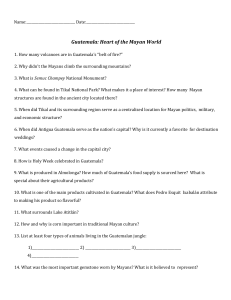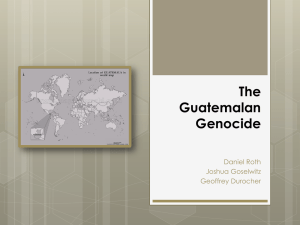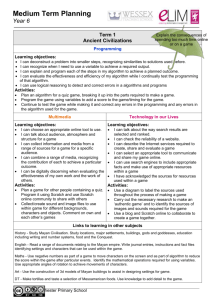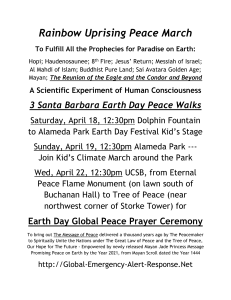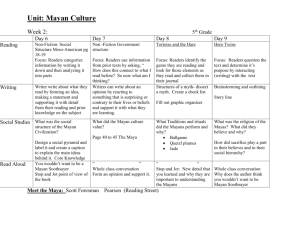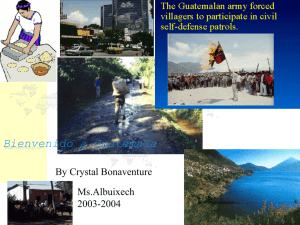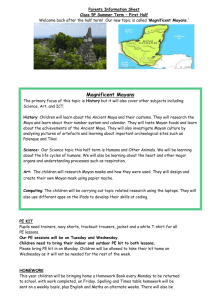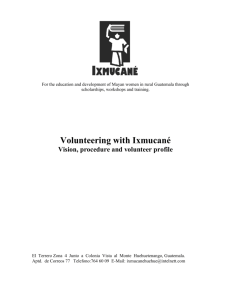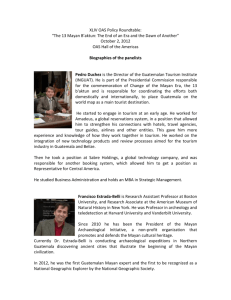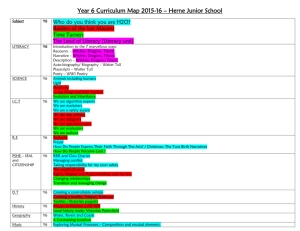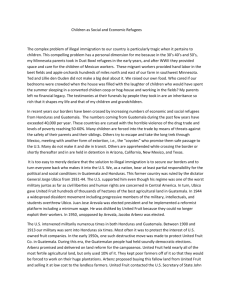before the genocide Guatemala is a mainly mountainous country in
advertisement
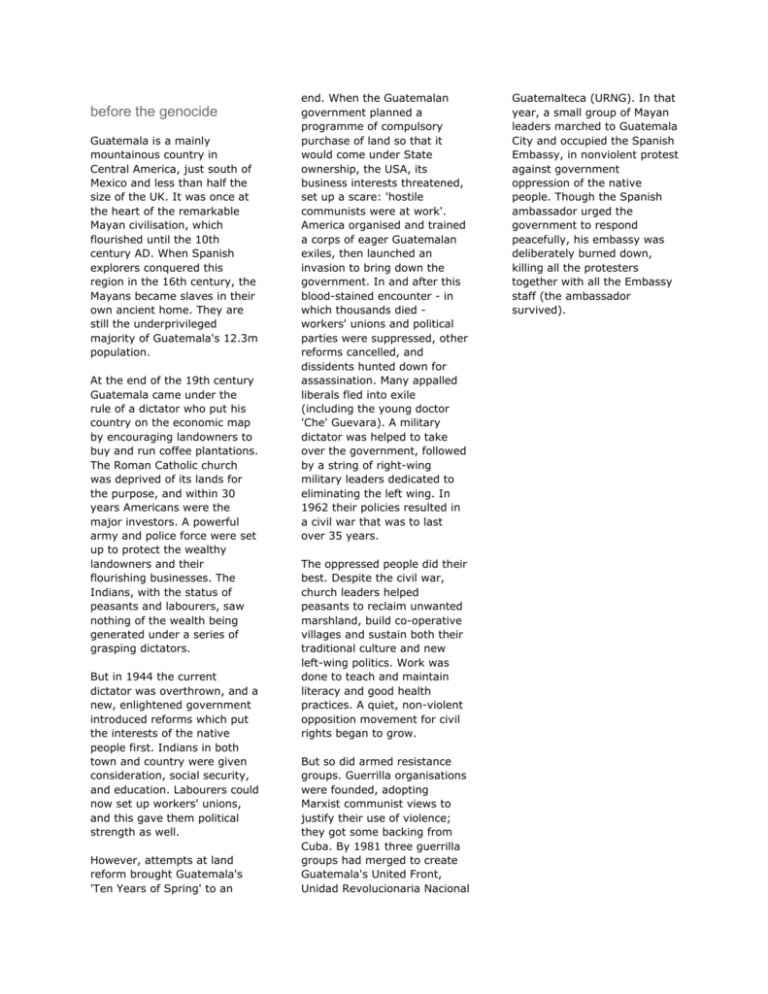
before the genocide Guatemala is a mainly mountainous country in Central America, just south of Mexico and less than half the size of the UK. It was once at the heart of the remarkable Mayan civilisation, which flourished until the 10th century AD. When Spanish explorers conquered this region in the 16th century, the Mayans became slaves in their own ancient home. They are still the underprivileged majority of Guatemala's 12.3m population. At the end of the 19th century Guatemala came under the rule of a dictator who put his country on the economic map by encouraging landowners to buy and run coffee plantations. The Roman Catholic church was deprived of its lands for the purpose, and within 30 years Americans were the major investors. A powerful army and police force were set up to protect the wealthy landowners and their flourishing businesses. The Indians, with the status of peasants and labourers, saw nothing of the wealth being generated under a series of grasping dictators. But in 1944 the current dictator was overthrown, and a new, enlightened government introduced reforms which put the interests of the native people first. Indians in both town and country were given consideration, social security, and education. Labourers could now set up workers' unions, and this gave them political strength as well. However, attempts at land reform brought Guatemala's 'Ten Years of Spring' to an end. When the Guatemalan government planned a programme of compulsory purchase of land so that it would come under State ownership, the USA, its business interests threatened, set up a scare: 'hostile communists were at work'. America organised and trained a corps of eager Guatemalan exiles, then launched an invasion to bring down the government. In and after this blood-stained encounter - in which thousands died workers' unions and political parties were suppressed, other reforms cancelled, and dissidents hunted down for assassination. Many appalled liberals fled into exile (including the young doctor 'Che' Guevara). A military dictator was helped to take over the government, followed by a string of right-wing military leaders dedicated to eliminating the left wing. In 1962 their policies resulted in a civil war that was to last over 35 years. The oppressed people did their best. Despite the civil war, church leaders helped peasants to reclaim unwanted marshland, build co-operative villages and sustain both their traditional culture and new left-wing politics. Work was done to teach and maintain literacy and good health practices. A quiet, non-violent opposition movement for civil rights began to grow. But so did armed resistance groups. Guerrilla organisations were founded, adopting Marxist communist views to justify their use of violence; they got some backing from Cuba. By 1981 three guerrilla groups had merged to create Guatemala's United Front, Unidad Revolucionaria Nacional Guatemalteca (URNG). In that year, a small group of Mayan leaders marched to Guatemala City and occupied the Spanish Embassy, in nonviolent protest against government oppression of the native people. Though the Spanish ambassador urged the government to respond peacefully, his embassy was deliberately burned down, killing all the protesters together with all the Embassy staff (the ambassador survived). the genocide The Guatemalan government, using the Guatemalan Army and its counter-insurgency force (whose members defined themselves as 'killing machines'), began a systematic campaign of repressions and suppression against the Mayan Indians, whom they claimed were working towards an communist coup. Their 2-year series of atrocities is sometimes called 'The Silent Holocaust'. In the words of the 1999 UNsponsored report on the civil war: 'The Army's perception of Mayan communities as natural allies of the guerrillas contributed to increasing and aggravating the human rights violations perpetrated against them, demonstrating an aggressive racist component of extreme cruelty that led to extermination en masse of defenceless Mayan communities, including children, women and the elderly, through methods whose cruelty has outraged the moral conscience of the civilised world.' Working methodically across the Mayan region, the army and its paramilitary teams, including 'civil patrols' of forcibly conscripted local men, attacked 626 villages. Each community was rounded up, or seized when gathered already for a celebration or a market day. The villagers, if they didn't escape to become hunted refugees, were then brutally murdered; others were forced to watch, and sometimes to take part. Buildings were vandalised and demolished, and a 'scorched earth' policy applied: the killers destroyed crops, slaughtered livestock, fouled water supplies, and violated sacred places and cultural symbols. Children were often beaten against walls, or thrown alive into pits where the bodies of adults were later thrown; they were also tortured and raped. Victims of all ages often had their limbs amputated, or were impaled and left to die slowly. Others were doused in petrol and set alight, or disembowelled while still alive. Yet others were shot repeatedly, or tortured and shut up alone to die in pain. The wombs of pregnant women were cut open. Women were routinely raped while being tortured. Women - now widows - who lived could scarcely survive the trauma: 'the presence of sexual violence in the social memory of the communities has become a source of collective shame'. Covert operations were also carried out by military units called Commandos, backed up by the army and military intelligence. They carried out planned executions and forced 'disappearances'. Death squads (some of which in time came under the army's umbrella), largely made up of criminals, murdered suspected 'subversives' or their allies; under dramatic names, such as 'The White Hand' or 'Eye for an Eye', they terrorised the country and contributed to the deliberate strategy of psychological warfare and intimidation. URNG's guerrillas could not provide assistance to the Mayan Indians: there were too few of them. There were certainly too few to be a real threat to the State, whose massive and brutal campaign was largely driven by longterm racist prejudice against the Mayan majority. Of the human rights violations recorded, the State and the Army were responsible for 93%, the guerrillas for 3%. Throughout the period of the genocide, the USA continued to provide military support to the Guatemalan government, mainly in the form of arms and equipment. The infamous guerrilla training school, the School of the Americas in Georgia USA, continued to train Guatemalan officers notorious for human rights abuses; the CIA worked with Guatemalan intelligence officers, some of whom were on the CIA payroll despite known human rights violations. US involvement was understood to be strategic or, put another way, indifferent to the fate of a bunch of Indians - in the wider context of the Cold War and anti-Communist action.
